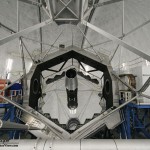It is an observation I have made before, but one that continually amazes me… Each Keck telescope consists of three hundred tons of steel and glass, with one simple purpose, to hold a few grams of aluminum in the perfect shape necessary to collect the light from distant stars and galaxies.

The layer is just thick enough to reflect nearly all of the light, any thinner and too much light would penetrate the mirror, any thicker and small variations in the coating would begin to distort the shape of the mirror.
How much aluminum?
Density of Al…
2.70g/cm³
Area of a Keck Primary…
36 x 2.598 x (0.9m)² = 75.75m²
Mass of Al…
2.70g/cm³ x 75.75m² x 100nm x 1,000,000cm³/m³ = 20.45g
20.45g = 0.71oz (if you prefer imperial)
Just how much aluminum is really on each Keck primary mirror? Simple enough to calculate… just multiply the surface area of thirty six hexagons by the thickness of the aluminum layer to figure the total mass of metal used.
The figures are found in the sidebar, and the answer is surprisingly little, about 20.5g. In comparison, an empty 12oz soda can weighs about 15g, thus it take a bit more than one soda can of aluminum to cover the Keck’s 10 meter primary mirror.
There is much more to a telescope than just one simple layer of aluminum. But that one component is critical. It is the mirror that gets a great deal of the attention. The primary mirror is what gives a large observatory the ability to capture light from the earliest eras of the universe, billions of years in the past.
